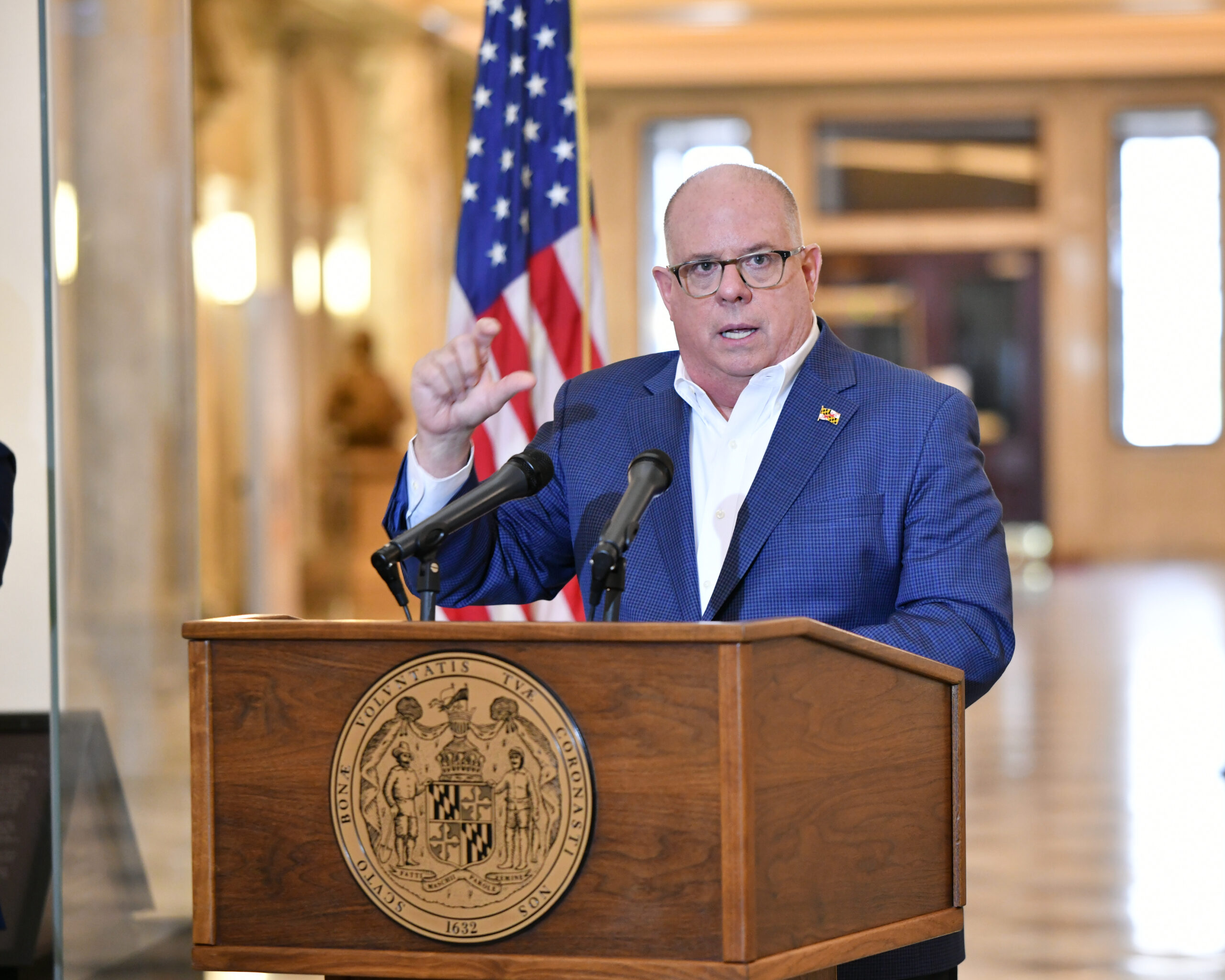Hogan Envisions a More Conventional General Election Voting Process

Marylanders will have to fill out an absentee ballot request if they want to vote by mail in the fall, Republican Gov. Lawrence J. Hogan Jr. announced Wednesday.
The decision comes after local election officials, prominent state lawmakers and advocates urged Hogan to order elections officials to automatically mail ballots to registered voters in the state — just as they did for last month’s primary. Hogan instead ordered the State Board of Elections to promptly mail every voter an absentee ballot request.
“The fundamental responsibility of the State Board of Elections is to conduct free and fair elections in a manner that facilitates maximum voter participation,” Hogan said in a statement. “This approach — which is already fully authorized by existing state law — will maximize participation in the November election by offering voters more options while minimizing confusion and risk during the COVID-19 pandemic.”
Hogan also ordered election officials to open every in-person and early voting center to avoid the hours-long lines seen in the state’s June 2 primary, when each jurisdiction had limited polling places. He wrote that election officials should encourage voters to vote by absentee ballot, in early voting or at off-peak times.
“While I know you have been inundated with suggestions from political leaders in both parties and special interest groups to change the electoral process, this discussion should not be subject to undue partisanship or political influence,” Hogan wrote. “Providing citizens with accessible, accountable, and transparent ways to cast their ballot is an essential component of our democratic republic and your primary responsibility.”
The State Board of Elections indicated it would comply with Hogan’s orders in a Wednesday afternoon news release.
“The Board will move forward with plans for a traditional general election on November 3rd and will expand efforts to promote voting by mail, early voting, and voting at off-peak times,” the statement said. “The Board will continue to work closely with local boards of elections, stakeholders, and the general public to conduct a safe and accessible general election.”
Prominent Democratic state lawmakers, local election officials and advocates had called for another mail-in election in the lead-up to Hogan’s decision. Maryland Senate President Bill Ferguson (D-Baltimore City) and Senate Education, Health and Environmental Affairs Committee Chairman Paul G. Pinsky (D-Prince George’s) called for a “hybrid mail-in preferred” election in a June letter to election officials.
Sen. Cheryl C. Kagan (D-Montgomery), the vice chair of the EHEA panel, was quick to condemn Hogan’s decision.
“I’m surprised and disappointed that Gov. Hogan caved to the fearmongering of President Trump,” Kagan told Maryland Matters. “The option he chose will definitely reduce voter participation and force voters to make a choice between standing in long lines to vote in person, or not voting at all.”
Ferguson and House Speaker Adrienne A. Jones (D-Baltimore County) issued a statement Wednesday afternoon expressing relief that Hogan had made an announcement but warning that the governor will need to provide sufficient resources to ensure that the election is a success.
“We share the concerns that local election officials will not have the staff or resources to process that many Vote By Mail applications in a timely manner,” the presiding officers said in their statement. “The Governor must provide the necessary resources to the local and state boards for personal protective equipment, additional staff and a robust awareness campaign. We hope the Governor will maintain maximum flexibility so that, should the pandemic worsen, or Election Judges are unable to be found, we can pivot to ensure that no Maryland voter is disenfranchised. It is now incumbent upon every election official and elected leader to work together to make this election a success. Failure is not an option.”
Hogan issued his order just as the legislature’s COVID-19 workgroup was holding its weekly online meeting. The meeting opened with Ferguson — at that point unaware of the governor’s decision — urging him to act swiftly.
“Each day that we continue without a decision increases the likelihood that we will have problems in the election this November,” he said.
At the end of the lawmakers’ meeting, Ferguson informed his colleagues about the governor’s order.
The State Board of Elections itself was split along party lines when it came to how to conduct the November elections. While the board’s Vice Chair Patrick J. Hogan and his fellow Democrat Malcolm L. Funn wanted ballots mailed to every registered voter in the state, Chairman Michael R. Cogan, along with his fellow Republicans Kelley A. Howells and William G. Voelp, supported requiring voters to fill out an application if they want a mail-in ballot.
Cogan was concerned that, if ballots are sent to outdated addresses, voter confidence in the state’s elections would plummet.
“I’m not sure the voters have confidence in an election if they’re seeing ballots crop up for people that aren’t there,” Cogan said at a State Board of Elections meeting last week.
Prominent Republican lawmakers have also urged election officials to use absentee ballots instead of mailing everyone a ballot. In a letter to election officials last month, Senate Minority Leader J.B. Jennings (R-Harford) and Minority Whip Stephen S. Hershey Jr. (R-Upper Shore) raised red flags over potential voter fraud in mail-in elections.
Research has shown that voter fraud in mail-in elections is miniscule – and advocates have repeatedly warned that requiring voters to fill out an application for their ballot could decrease participation in the November elections.
“Because of the ongoing COVID-19 public health crisis, we cannot assume it will be safe to run our November elections with predominantly in person voting,” a letter to Hogan from various advocates reads. “We do know that delaying the decision will jeopardize SBE’s ability to run a safe, secure and efficient election process, and could lead to even more problems than those experienced in the Primary Election.”
Local election officials recently wrote that requiring voters to fill out applications before receiving their ballots caused confusion in other states, and would put a strain on election boards across the state.
“We cannot overstate the devastating consequences likely to result if the State of Maryland does not plan now to mail every voter a ballot for the 2020 Presidential General Election,” David Garreis, the president of the Maryland Association of Election Officials and deputy director of the Anne Arundel County Board of Elections, wrote to Hogan, state Elections Administrator Linda H. Lamone and Cogan, the state board chairman.
The June 2 primary election was Maryland’s first statewide vote conducted largely by mail. While the election saw high voter turnout, it was also rife with errors. Many voters, particularly those in Baltimore city, received late or incorrect ballots. Voters who opted to vote at limited polling locations were met with hours-long wait times.





 Creative Commons Attribution
Creative Commons Attribution